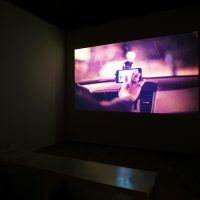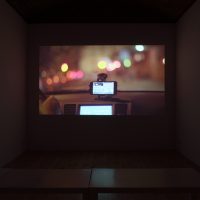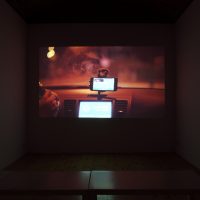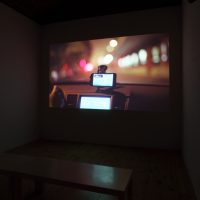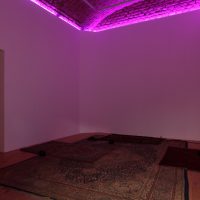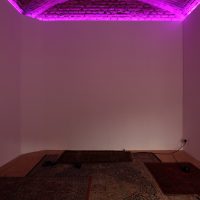31/5 — 29/6/2018
Max Dvořák is a director of people, images, sounds, and smells. Shisha Lounge Exclusive is a narrative and conceptual situation. Narrative because it tells a particular story of which even the viewer is a potential component. Conceptual because much remains unspoken. This unspokenness is a necessary precondition for being in Shisha Lounge Exclusive – perhaps it is the only state in which one can be here. But let us start at the beginning; there are sensory experiences: people, sight, sound, smell. Or in the reverse order. In order to get ready for sight and sound, first inhale the scent from the diffusers. Don’t ask why – that’s not all that important. What is important is that you relax and prepare yourselves. Certain events require caution. Inhale the pleasant scent. Explore the patterns on the carpet. Read this text, and a hostess will give you a smile. Soon, you will see a new film.
You may not know it, but you are being directed by the artist. You have entered into a waiting room. If you accept the artist’s directing, you wait. You can have a seat and look around, or you can converse with the hostess. You are in a state of anticipation. Finally, the hostess shows you into the auditorium. The film starts. You hear voices. They are talking about the murders of taxi drivers. The possibility of sudden dramatic action is in the air. Undoubtedly, you can feel echoes of the genre conventions of psychological thrillers. But no dramatic situation is forthcoming. The potential remains unspoken. The people get out and the driver puts on a video to relax. Inner balance is achieved by watching someone else’s imbalance in two dimensions.
The stand-up comedy playing on a telephone evokes the specific genre of the home video in which the kidnappers film their victim in order to blackmail someone. The scene, which consists of one single prop and bright front lighting, reminds us of crime stories in which the characters’ inentions and motifs are immediately apparent. Max Dvořák uses this atmosphere to show the carefully hidden pathology that the stand-up comic subtly insinuates during his long routine. As we watch the monologue of this strange figure with a microphone and a carpet in the background, we are not sure whether it is a rehearsed monologue, a sophisticated threat, or an attempt at a humorous etude. If anything, the audience’s laughter evokes a sense of tension and uncertainty. It acts as a catalyst of repressed tension without which the whole thing might feel ridiculous, even though the laughter lends truth to the notion that when we laugh it is an escape from a hopeless situation. We laugh when we don’t know how to react; there is nothing else we can do, no chance for protest, and silence would mean agreement.
The laughter dies down and the film ends. If you were hoping for a dramatic ending, you will be disappointed. You leave with an unanswered question, and the cinematic situation ends where it started: with the subtle threat awaiting the next group of filmgoers.
curated by František Fekete

